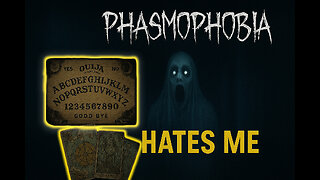Premium Only Content

Episode 3137: From Blueprint to Breakdown: Drafting of Sacrosanctum Concilium - Morning Episode
Nightly Zoom Coordinates for Rosary:
Meeting ID: 865 8978 0399
Passcode: Wjjv4960!
Speak Lord for your Servant is Listening
Book Recommendation of the Day
St. Elizabeth of Portugal by Fr. Vincent McNabb, O.P.
A classic and reverent biography written by a Dominican priest whose luminous writing brings this holy queen's virtues and trials to life. An excellent choice for readers seeking a full-length, traditional account rooted in Catholic devotion.
So far on this series of the Liturgical Revolution I’ve discussed
“From Blueprint to Breakdown: Beauduin and the Drafting of Sacrosanctum Concilium”
A Traditional Catholic critique of the Vatican II Constitution on the Sacred Liturgy, exposing how Dom Lambert Beauduin’s vision shaped the modern liturgical crisis.
INTRO: CALLING TRADITIONAL MINDS TO ATTENTION
“What the soul is to the body of man, so is the liturgy to the Body of Christ.” — St. John Eudes
Today we take you behind the veil of Vatican II’s first major document Sacrosanctum Concilium the Constitution on the Sacred Liturgy, and we ask:
“Was this the organic renewal the Church needed, or the blueprint for rupture?”
This is Episode 3 of our series on the liturgical revolution. If Episode 1 and 2 traced the modern errors to Dom Lambert Beauduin, today we examine how his theology was codified into Council law.
PART I: THE DOCUMENT THAT OPENED THE DOOR
What is Sacrosanctum Concilium?
Promulgated on December 4, 1963, SC was the first Constitution to emerge from Vatican II. It had 130 sections and was hailed as a modest effort to renew the liturgy.
But what did it do?
• Affirmed the continued use of Latin, while permitting vernacular (SC 36)
• Called for a simplification of rites (SC 21, 34)
• Recommended “active participation” of the faithful (SC 14)
• Opened the door to inculturation and regional adaptation (SC 37–40)
The document appeared pastoral, but it was constructed with strategic ambiguity language open to both conservative and radical interpretation. These ambiguities would later be weaponized by reformers.
PART II: DOM LAMBERT BEAUDUIN – THE HIDDEN ARCHITECT
Who was Beauduin?
• A Belgian Benedictine monk (1873–1960)
• Author of La Piété de l’Église (1914), translated as Liturgy and the Life of the Church
• Early leader of the Liturgical Movement, promoting “participation,” vernacular, and ecumenism
How was he influential?
His ideas predated Vatican II by 50 years, but through protégés and collaborators (Louis Bouyer, Romano Guardini, Jungmann), Beauduin’s vision made its way into the very schema for SC.
He proposed that:
• The liturgy must be accessible to the people
• Participation must be external and vocal
• The Church should strive for unity with Protestants and Eastern Orthodox via liturgical reform
This theological modernism masked as pastoral concern was now canonized at the Council.
PART III: THE THEOLOGICAL ERRORS OF SC INFUSED WITH BEAUDUIN’S SPIRIT
Let’s analyze the core themes that reflect his influence.
1. Redefining “Active Participation”
SC 14: “Mother Church earnestly desires that all the faithful should be led to that full, conscious, and active participation in liturgical celebrations…”
What Beauduin meant:
That every lay person must be seen, heard, and involved through responses, movements, ministries, etc.
What the Church traditionally taught:
Interior participation through recollection, adoration, and union with the priest’s sacrifice.
St. Pope Pius X in Tra le Sollecitudini (1903) encouraged “active participation” through Gregorian chant not liturgical activism.
Pope Pius XII warned in Mediator Dei (1947):
“One would be straying from the path of truth were he to assign to external actions alone the notion of liturgical participation.”
2. Opening the Door to the Vernacular
SC 36: “The use of the Latin language is to be preserved… but the use of the mother tongue may frequently be of great advantage.”
This "but" clause was all the leverage needed. Reformers, claiming “advantage,” swept Latin out within a few years.
Beauduin’s position (1914):
He argued Latin hindered comprehension and blocked unity.
Pope John XXIII, however, wrote in Veterum Sapientia (1962):
“The Latin language... must be preserved with great care.”
Yet SC contradicts this just months later. Beauduin’s theory prevailed.
3. Ambiguity Around the Sacrificial Nature of the Mass
SC 7: “Christ is always present… especially under the Eucharistic species.”
SC 10: “The liturgy is the summit toward which the activity of the Church is directed.”
Nowhere in the document is the propitiatory nature of the Mass clarified in the traditional sense.
The Council of Trent condemned the notion that the Mass is only a memorial meal:
“If anyone says that the Sacrifice of the Mass is a mere commemoration of the sacrifice consummated on the Cross… let him be anathema.” (Session XXII, Canon 3)
Beauduin’s theology downplayed the language of sacrifice, emphasizing community and celebration a modernist shift now echoed in SC.
PART IV: STRATEGIC AMBIGUITY AND POST-CONCILIAR REVOLUTION
Why didn't faithful bishops object more loudly?
Because the language was cleverly worded. Phrases like:
• “The use of Latin is to be preserved” (SC 36)
• “The faithful should be able to say or sing… in Latin or vernacular” (SC 54)
• “The rites are to be simplified” (SC 34)
These seemed balanced. But once the Council ended, all interpretive power was handed to the Consilium, the body created to reform the liturgy.
The Role of the Consilium (More in Episode 3)
• Led by Archbishop Annibale Bugnini
• Used SC as a mandate for massive restructuring
• Claimed they were being “faithful to the Council”
But it was the spirit of Beauduin, not the perennial tradition, that guided them.
Cardinal Heenan of Westminster would later lament:
“At home, it is not only the vernacular but a completely new rite of Mass... I cannot recognize it.”
PART V: ORGANIC DEVELOPMENT vs. LITURGICAL ENGINEERING
The traditional liturgy developed over 1,500 years, culminating in the Missal of St. Pius V (1570), which codified the ancient Roman Rite after the Council of Trent.
Pope St. Pius V declared:
“This Missal is to be used in perpetuity. No priest shall ever be required to say any other Mass.”
Beauduin and his successors viewed this as too rigid. They approached liturgy like a scholar would a text: something to be dissected and rebuilt.
Archbishop Lefebvre wrote:
“They made a new Mass. They changed everything because they changed theology.”
CONCLUSION: THE BLUEPRINT BECAME A WRECKING BALL
Dom Lambert Beauduin wanted to “revive” the liturgy. But his ideas, adopted in Sacrosanctum Concilium, became the basis for a new liturgical paradigm not a reform, but a rupture.
• The emphasis on external participation over interior union
• The push for vernacular over Latin
• The eclipse of the sacrificial nature of the Mass
• The loss of sacred silence, mystery, and continuity
These were not accidents. They were the fruit of theological errors planted decades before Vatican II, and Sacrosanctum Concilium gave them legislative force.
As we journey through the Season after Pentecost, we are reminded that the Holy Ghost, poured forth upon the Church at Pentecost, continues to animate, sanctify, and guide us in the truths handed down through the Apostles and Saints.
Today, July 8th, we ponder the path of the just as described in Sacred Scripture, and Christ’s profound invitation to be light in a world dimmed by error. In the midst of darkness, confusion, and worldly distractions, Holy Mother Church draws our attention back to the essentials: virtue, truth, and fidelity.
Epistle – Romans 6:19–23
“Brethren: I speak a human thing, because of the infirmity of your flesh: for as you have yielded your members to serve uncleanness and iniquity unto iniquity; so now yield your members to serve justice, unto sanctification. For when you were the servants of sin, you were free from justice. What fruit therefore had you then in those things of which you are now ashamed? For the end of them is death. But now being made free from sin, and become servants to God, you have your fruit unto sanctification, and the end life everlasting. For the wages of sin is death. But the grace of God, life everlasting in Christ Jesus our Lord.”
Reflection on the Epistle
St. Paul lays out one of the clearest and most powerful contrasts in all of Scripture: sin versus sanctity, death versus eternal life. He invites the Christian to examine their past with sober humility: “What fruit had you then in those things of which you are now ashamed?”
The Christian life is not a mere improvement plan it is a complete transformation, a death to sin and rebirth in grace. And this grace is not passive it demands yielding to justice, to virtue, to sanctification.
We live in a time when sin is celebrated and justice is redefined by the whims of man. But the traditional Catholic knows: there is only one true justice that which conforms to the eternal law of God.
Let us not forget: the wages of sin is death. This is not poetic exaggeration, but a divine truth. On the other hand, God’s grace brings life everlasting. May we never grow weary of this battle for holiness.
Gospel – Matthew 5:13–19
“At that time, Jesus said to His disciples: You are the salt of the earth. But if the salt lose its savor, wherewith shall it be salted? It is good for nothing any more but to be cast out and to be trodden on by men. You are the light of the world. A city seated on a mountain cannot be hid... So let your light shine before men, that they may see your good works and glorify your Father who is in heaven. Do not think that I am come to destroy the law, or the prophets. I am not come to destroy, but to fulfill. Amen I say unto you, till heaven and earth pass, one jot or one tittle shall not pass of the law, till all be fulfilled.”
Reflection on the Gospel
Here Our Blessed Lord gives us both a mission and a warning.
He calls His disciples us the salt of the earth and the light of the world. But He also warns that if we lose our savor, if our faith becomes tepid, we become useless and destined to be cast out and trodden on by men.
This is not a time to hide our faith. It is a time to shine forth, to be visible, public, unwavering. Christ makes clear that our faith is not meant to be kept hidden under a bushel but placed where it illuminates the lives of others.
He also reminds us that He has not come to abolish the law, but to fulfill it. What is more traditional than this? In an age of doctrinal confusion and moral relativism, Our Lord's words ring like a bell through the fog: the law remains, the truth remains, and the standard of holiness has not been lowered.
Let us be courageous witnesses, deeply rooted in the truth, and radiant with the light of Christ, so that others may glorify God.
Saint of the Day – St. Elizabeth, Queen of Portugal (†1336)
In the traditional calendar, St. Elizabeth of Portugal is honored on July 8. A queen, peacemaker, and widow, she lived a life of charity and mortification. She used her royal position not for indulgence, but for justice and the service of Christ’s poor. After the death of her husband, she retired to a convent of Poor Clares.
St. Elizabeth is a model of how holiness can and must be lived in every state of life even in the halls of power. Like today’s Gospel, she was a light on a hill, and like the just man in today’s epistle, her works bore fruit for eternity.
Quotes & Themes for Meditation
• “The wages of sin is death.” (Rom. 6:23)
→ We must flee from sin, not justify or accommodate it.
• “You are the light of the world.” (Matt. 5:14)
→ Every Catholic is called to be a public witness to truth and charity.
• St. Elizabeth of Portugal:
“He who has charity is in God, and God in him, for God is Charity.”
• Theme 1: Christian life requires ongoing sanctification, not just belief.
• Theme 2: Faith that is not visible is fruitless.
• Theme 3: Holiness sanctifies all vocations—kings, workers, priests, mothers, and children alike.
Conclusionary Prayer
Let us pray.
O Eternal High Priest and Light of the World, grant that we may live not for sin but for sanctity, not in darkness but in the full radiance of Thy truth. Make us the salt of the earth and the light of the world, that we may glorify Thee in word and deed.
Through the intercession of St. Elizabeth of Portugal, may we learn to rule our passions, foster peace, and love the poor. May her holy example inspire us to labor tirelessly for our salvation and for the sanctification of the world.
May Thy law be written on our hearts and never erased by fear, pride, or compromise.
Through Christ our Lord. Amen.
St. Elizabeth of Portugal, pray for us.
Our Lady, Mirror of Justice, guide us.
Sacred Heart of Jesus, inflame our hearts with divine charity.
Thank you for joining us today on Tradition and Triumph. Keep the flame of tradition burning in your home, your parish, and your heart and may your light so shine before men, that all may see your good works and glorify our Father in Heaven.
-

Barry Cunningham
6 hours agoBREAKING NEWS: PRESIDENT TRUMP IS GOING TO TAKE CHICAGO! LFG!!! (IT'S MOVIE NIGHT!)
71.7K41 -
 1:23:59
1:23:59
Man in America
7 hours agoTrump Demands Big Pharma Come Clean on Covid Shots w/ Dr. David Martin
21.8K16 -
 1:40:27
1:40:27
megimu32
3 hours agoOTS: Labor Day Sitcom Blowout - Tim, Ray, & Relatable Chaos!
21.9K2 -
 LIVE
LIVE
StevieTLIVE
3 hours agoWarzone Wins w/ FL Mullet Man
187 watching -
 1:04:01
1:04:01
BonginoReport
7 hours agoLefties Wish Death on Trump but He’s BACK! - Nightly Scroll w/ Hayley Caronia (Ep.125)
175K78 -
 3:18:28
3:18:28
Tundra Tactical
4 hours ago $0.49 earnedWe Survived the Military… But Not This Basement
17.8K -
 20:12
20:12
Clownfish TV
12 hours agoDisney Needs MEN Back?! They ADMIT Star Wars and Marvel are DEAD!
17.4K32 -
 1:37:00
1:37:00
Anthony Rogers
11 hours agoEpisode 381 - Tim Kelleher
11.8K1 -
 1:01:42
1:01:42
The Nick DiPaolo Show Channel
8 hours agoTDS Hits New Level! | The Nick Di Paolo Show #1786
48.6K38 -
 1:02:27
1:02:27
Michael Franzese
6 hours agoFace to Face with a Former Chinatown Gangster Turned NYPD Detective
48.7K13